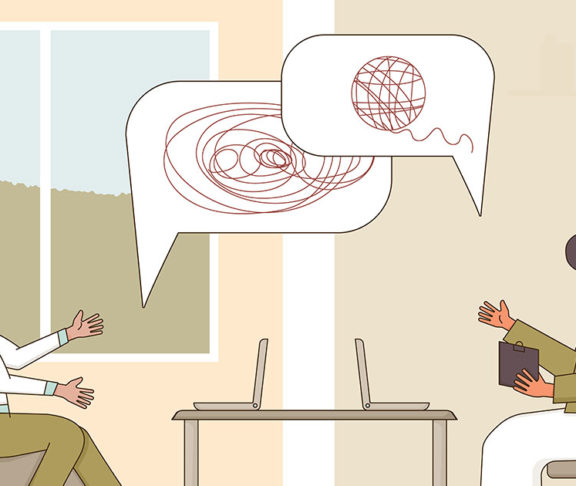Jen Arnold, M.S., RD/LDN, is the owner and founder of Redesigning Wellness, which aims to change the way workplaces approach wellness programs to address individual needs of the whole employee. We asked her about the challenges businesses are still facing as a result of the COVID-19 pandemic, as well as the keys to managing stress and promoting well-being.

Jen Arnold, M.S., RD/LDN
Owner and Founder, Redesigning Wellness
What advice do you have for business leaders about being resilient after having run a business during the COVID-19 pandemic?
Business leaders have been remarkably resilient as they navigated through the uncertainty, business impact, and stress of the COVID-19 pandemic. Now, as business leaders do, they want to move past it and look forward. Especially at this time of year, everyone is focused on 2022.
First, I recommend business leaders take some time to look back at what they’ve accomplished in an unusually long period of crisis. Take stock of the many challenges you’ve faced and how you’ve navigated those challenges. What went well? What didn’t, and how can you learn from it? How can you leverage everything you learned for future business operations?
Many business leaders excel in a crisis, especially when the adrenaline is pumping, and they are hyper focused on one thing: keeping their business running. After a while, living and working in crisis mode is exhausting to our bodies and brains.
The question now becomes, how are they holding up mentally, emotionally, and physically? Is their well-being intact? How about the well-being of their employees?
So secondly, rest and recovery are vital to managing one’s resilience, productivity, and mental capacity. At this point in the pandemic, many feel their mental capacity is overloaded. With the prevalence of emotional overwhelm, many are in some stage of burnout, which means their energy is depleted.
Taking and encouraging recovery breaks during the day, even if it’s two minutes, can help refresh our minds and bodies. At the end of the day, we all need to mentally detach from work when we go home (or step out of our home offices). We need to take vacations where we truly disconnect from work.
When I encourage employees to take short recovery breaks during work, I commonly hear that their leaders don’t take breaks. Leaders who check email at all hours and work while on vacation need to consider resting instead. Stepping away from our work can create insights or “a-ha” moments critical to the long-term success of organizations. Also, always being “on” sets the tone for the culture of an organization. If leaders are always on, then employees mimic that behavior, even if the leader tells them they should take a break.
Finally, don’t let up on mental health. When the pandemic first hit, organizations were responsive, providing mental health resources, like virtual counseling/telehealth, training, and relaxation apps. But then as leaders wanted to get back to “business as usual,” they tended to lessen their attention on mental health. It’s crucial now to continue acknowledging the importance of mental health while also managing the pace of the workload, and providing flexibility and resources.
How do you personally define resilience when talking about a business leader or employer?
I had one definition before the pandemic: “They had the ability to not get knocked off balance when challenges happened.” When the pandemic set in, I started using the American Psychological Association’s definition: “The process of adapting well in the face of adversity, trauma, tragedy, threats, or significant sources of stress.”
Since March 2020, most everyone has experienced adversity and loss, and many have had trauma or tragedy in their lives. I explain resilience in terms of the capacity to manage stress and adapt to change.
Some stress is good, but there’s a tipping point where the pace of stress outpaces the ability to handle it. When we are strained and overwhelmed, our brains don’t work right, emotions run high, we can feel disengaged with our work, and relationships can suffer.
Given the constant pressure and pace of work in organizations, employers need resilient employees. Pandemic or not, the pace and nature of work is changing. Whether it’s a reorganization, a shift in priorities, or getting a new leader, employees need to be able to successfully adapt to these changes.
Now that employers are returning to hybrid or full-time, in-person work arrangements, what advice do you have for HR and business leaders on keeping employees empowered and engaged while still managing COVID-related issues?
Setting clear expectations is the No. 1 job. When we are faced with uncertainty, our brains shift into threat mode. Ideally, employers will offer a choice of hybrid work arrangements and set expectations around what that looks like for their organization.
In setting expectations, employers can easily miss sending the message that they care about the safety and well-being of their employees. No one wants to work for a company that doesn’t care for them. This can be as simple as the top leaders saying “thank you” for all that the employees have done and continue to do.
Leaders may need to shift their own perspective to understand their employees’ needs better. The CEO may be ready to be back in the office, but they most likely have the resources they need (childcare, an office to themselves, control, etc.) to make it an easier transition. Employees may be anxious about being with people again, wondering if they’ll get sick, how they’ll juggle childcare, etc. It goes a long way when leaders check in with their team members to see how they’re doing.
Assess the “pulse” of the workforce. Companies can conduct a quick survey where employees can anonymously submit a word about how they feel about being in the office. Understanding the mood of the office can help leaders adjust communications, policies, and resources. This also helps employees get clear about their emotions before they lose their cool on their co-workers.
I want to highlight HR professionals and all they have faced. They’ve been thrown into managing the safety of a workforce during a pandemic — mask policies, social distancing, employee complaints, and mandates, just to name a few of the challenges. Make sure the HR team is getting the resources, recognition, and recovery they deserve.
How do you see the workforce changing as employers transition workers back into the office?
If employers adopt and support the ability to work remotely, there will be less need for big offices or office space. Employees will be able to work in more flexible settings, whether that’s at home, a coffee shop, or in an RV. What I’d love to see is more employers truly embracing location independence, where workers can work from anywhere (and not get a pay reduction because of where they live). Why does it really matter where someone works if they are available and able to collaborate effectively during core business hours?
Not only will employers save on office space if they embrace remote work, they can access a larger talent pool: stay-at-home moms who want to work but don’t want to come into an office, spouses of military personnel who have to be in certain locations, and retirees who may want part-time work, for example.

